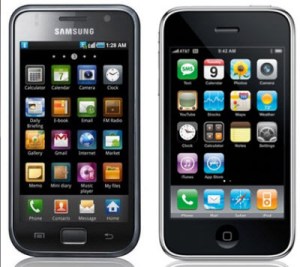 There’s a war brewing. Apple and Samsung are selling half of all smartphones and the two technology giants will increasingly fight for the remaining turf, IDC researchers said Friday. Overall, the smartphone market grew just 42.1 percent in the second quarter of 2012 — the lowest since late 2009.
There’s a war brewing. Apple and Samsung are selling half of all smartphones and the two technology giants will increasingly fight for the remaining turf, IDC researchers said Friday. Overall, the smartphone market grew just 42.1 percent in the second quarter of 2012 — the lowest since late 2009.
Globally, 406 million smartphones shipped during the second quarter of this year, up just slightly from the 401.8 million units during the second quarter of 2011. Samsung is the No. 1 smartphone producer, selling 50.2 million devices in the second quarter, for 32.6 percent of the market, according to IDC’s Worldwide Mobile Phone Tracker. That’s a 172 percent increase over the same period in 2011, when the South Korean company shipped 18.4 million smartphones for 17 percent of the market.
Apple saw its number of smartphone shipments increase, but its marketshare slide. The Cupertino, Calif. iPhone maker shipped 26 million smartphones in the second quarter, for 16.9 percent of the market. That’s compared to 20.4 million units and 18.8 percent of the market during the same period in 2011.
“Samsung and Apple have quickly become the global smartphone heavyweights though both deploy different approaches to the market,” IDC analyst Kevin Restivo said. Samsung uses a ‘shotgun strategy’ producing many models for a wide range of markets, he said. Apple, on the other hand, creates only a few high-profile models. Both companies “will inevitably come into greater conflict as both try to generate additional gains,” Restivo said.
The battleground likely will be emerging markets, such as China and India, where demand for mobile phones remains high despite the economic uncertainty that has held North American and European consumers hostage. The emerging markets due to their size and growth will “continue to be strong contributors” to smartphone sales, the research firm said.
Signaling how much the mobile phone market has changed, Nokia — once the king of the hill — now has a single-digit market share of 6.6 percent. The company, which is attempting to change horses in midstream, saw a 38.9 percent drop in smartphone sales in the second quarter, according to IDC. Nokia sold 10.2 million smartphones for the quarter, it’s market share falling to 6.6 percent from 15.4 percent a year ago.
VentureBeat's mission is to be a digital town square for technical decision-makers to gain knowledge about transformative enterprise technology and transact. Learn More
